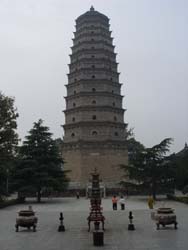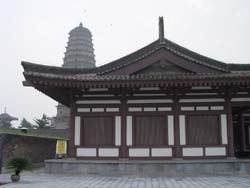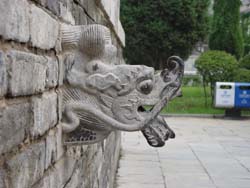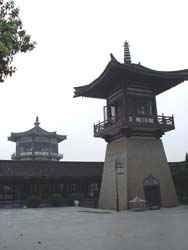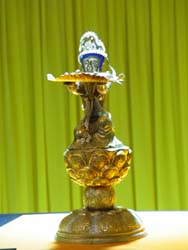A large pilgrimage square is being built near the Famen Temple, a famous Buddhism establishment in
Shaanxi Province. The project is scheduled to be completed by the end of 2008, Yao Yinliang, a top Party official of local Baoji City told China.org.cn on September 3.
On the first day of the Chinese lunar New Year in 2006, a record number of 72,000 devout believers flooded into to the Famen Temple, which houses several genuine relics of Gautama Buddha (Sakyamuni). Thousands of cars jammed the expressway for miles. During the 2007 New Year, even more pilgrims flocked to the temple.
Many Chinese have a belief that offering a sacrifice to Buddha on the first day of the New Year would bring them good fortune and success during the year.
To meet the pilgrimage, a plan to build a large square has been implemented after getting approval from the State Council. The large square is designed to hold some 100,000 worshipers at the same time.
Besides the large square, a 147-meter-high dagoba will also be built to make offering to the Buddhist relics. Li Zuyuan, a famous architect from Taiwan, designed the dagoba, consisting of 40,500 square meters.
Famen Temple is situated about 10 km north of the county seat of Fufeng in Shaanxi Province, and 120 km west of Xi'an, a hot tourism city celebrated globally for its Terracotta Army.
Famen refers to "gate to Buddhist dharma" (law). It is said that the temple was first built in the tenth year of the Emperor Ming Di's reign (AD 67) during the Eastern Han Dynasty.
Between the end of the Han Dynasty and the middle of the Tang Dynasty (618-907), Buddhism gradually spread throughout China, appealing to all levels of society, men and women alike. It offered a rich body of scriptures (sutras) and various means of attaining personal salvation that could not be found, for example, in Confucian traditions. Monasteries, along with their monks and nuns, were freed from some of the restrictions placed on the rest of society. Temples grew rapidly, becoming rich with offerings and communal gifts.
Relics (sarira) and other precious objects were placed beneath the foundations of a pagoda at many major monastic establishments. The practice originated in India, with the building of sacred mounds called stupas over the scattered remains of Sakyamuni, who died about 500 BC.
Famen Temple was located not far from the Tang capital of Chang'an (present-day Xi'an) and received state support under at least seven emperors. The centerpiece of the relics was a set of four finger bones that were believed to be those of the Buddha himself.
Emperors of the Sui (581-618) and Tang dynasties believed that enshrining and worshiping Sakyamuni's bones would bring riches and peace to their land and people.
About every thirty years, these relics along with related objects were taken out and paraded to the capital, where they were put on display inside the imperial palace.
While such practices appealed to the faithful, they also raised protests from those concerned with state support of a foreign religion at a time when China's borders were coming under increasing pressure.
The situation reached crisis proportions. From AD 841 to 845 Buddhism was suppressed, monasteries were converted to other uses, and thousands of monks and nuns were forced to return to lay life.
Monks being free of military service and temple-owned lands being free of taxation were two more excuses rulers used to suppress Buddhism.
In the later part of the Tang Dynasty, the Famen Temple shrunk significantly and the finger-bone relics disappeared as a result of the suppression of Buddhism, possibly to protect them. Since their disappearance, Chinese Buddhists have tried in vain to find them for many centuries.
On August 24, 1981, half of the old Pagoda collapsed. In 1986, government decided to restore the pagoda. Surprisingly, during the April 1987 restoration work, Chinese archaeologists rediscovered the Buddha's figure bone relics in a crypt near the old pagoda site. The rediscovery occurred on the very birthday of Sakyamuni.
Along with the relics of Sakyamuni's finger bones, over 2,000 priceless royal treasures and jewels of the Tang Dynasty were found in the crypt.
This unprecedented discovery ignited great excitement among Buddhists, archaeologists and tourists all over the world. It was a major event in the history of Buddhism.
The Famen Temple has been destroyed and rebuilt so many times that it is now a fairly modern structure. During the ten-year-long turmoil of the Cultural Revolution (1966-1976), the Famen Temple was destroyed. In fact, Master Liangqing burned himself to death to guard the temple.
To showcase various unearthed treasures to the public, the Famen Temple Museum was established in 1987. On display are gold and silverware, colored glaze ware, porcelain and silks. Owing to the growing number of tourists two new exhibition halls were established in 2000, expanding the exhibition area from 500 square meters to 3,000 square meters.
Nowadays, the Famen Temple plays a sovereign role in Chinese Buddhism and appeals to tourists from all over the world.
Visiting info:
Admission fees: Famen Temple 28 yuan; Famen Temple Museum 45 yuan (Mar. to Nov.)
Recommended time for a visit: 3 hours
Private Transportation: Public expressway from Xi'an to Famen Temple, two hours driving time.
Public Bus route: Take Tourism Bus No. 2 at the Railway Station
(China.org.cn by staff reporter Wang Zhiyong, September 5, 2007)

